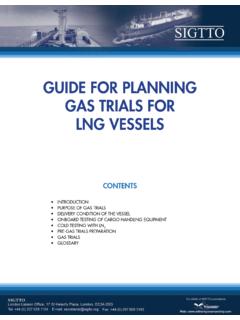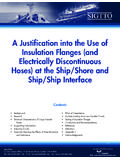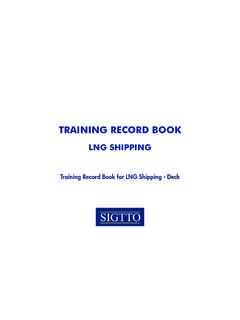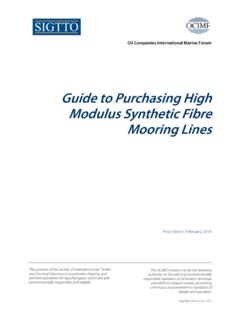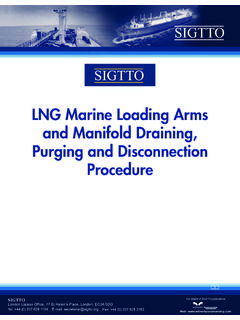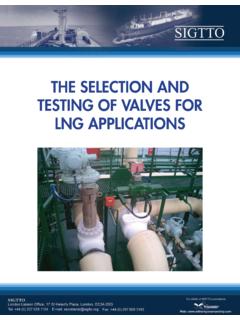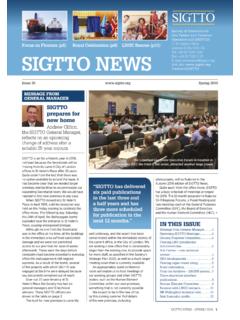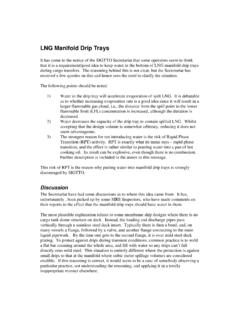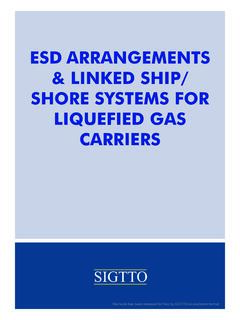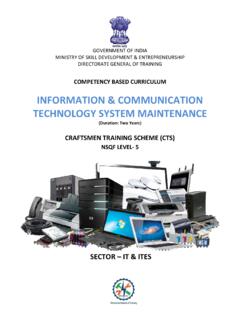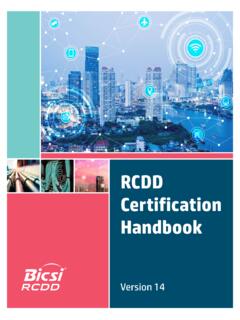Transcription of SIGTTO LNG and LPG Experience Matrix Guidelines for Use
1 ISIGTTO LNG and LPG Experience Matrix Guidelines for UseiiThe Society of International Gas Tanker and Terminal Operators ( SIGTTO )The Society of International Gas Tanker and Terminal Operators is a non-profit making organisation dedicated to protect and promote the mutual interests of its members in matters related to the safe and reliable operation of gas tankers and terminals within a sound environment. The Society was founded in 1979 and was granted consultative status at IMO in November of Terms of UseWhile the information and advice given in this Guide (Guide) has been developed using the best information currently available, it is intended purely as guidance to be used at the user s own risk. No warranties or representations are given nor is any duty of care or responsibility accepted by The Society of International Gas Tanker and Terminal Operators ( SIGTTO )
2 , the members or employees of SIGTTO , or by any person, firm, company or organisation who or which has been in any way concerned with the furnishing of information or data, the compilation or any translation, publishing, supply or sale of the Guide, for the accuracy of any information or advice in the Guide or any omission from the Guide or for any consequence whatsoever resulting directly or indirectly from compliance with, adoption of, or reliance on guidance contained in the Guide even if caused by failure to exercise reasonable SituationSummaryRecommendationsAnnex1 IntroductionThe SIGTTO LNG/LPG Officer Experience Matrix (the Matrix ) was published in 2011. The Society developed the Matrix after it had become apparent that a number of inconsistent matrices were being used by terminals and charterers within the LNG/LPG industry.
3 These inconsistencies were considered to be potentially counter-productive to safety, particularly as stop-gap measures might be taken to ensure temporary compliance with the requirements of different terminals or Matrix was recommended as a voluntary tool for assessing and managing risk and it was anticipated that it might be adopted as the industry standard from which to assess the adequacy of Experience and training for officers serving on board LNG/LPG carriers. It offered transparent guidance as to the assessment of appropriate levels of Experience and training for officers both as individuals, within a rank, and in combination, across Matrix considers a number of elements, including length of sea service, Experience in rank, Experience in LNG/LPG operations and training assessment.
4 It does not assess competency but adopts a presumption that compliance with all aspects is indicative of suitability for the the years since the Matrix was published, it has been brought to the attention of the Society that some terminals and charterers are applying it prescriptively, so that the levels of Experience are considered to be minimum thresholds, where any shortfall is unacceptable (no matter how small). By contrast, the Society s accompanying recommendation to the Matrix is that: in the event of non-compliance with a particular element of the Experience Matrix , consideration should be given to other mitigating factors, including bespoke training, the manning scale in place, time with the LNG/LPG ship owner/operator and the wider competence management systems employed by the ship operator in officer recruitment and development.
5 It was, therefore, agreed at GPC 73 (and subsequently approved by the board in May 2016) that the Secretariat should issue further guidance as to the recommended application of the Matrix in the assessment and management of SituationA number of instances have also been reported whereby charterers and terminals have rejected a ship on the basis that one officer has fallen just short of the minimum thresholds within the Matrix or matrices adopted. On some occasions such shortfall has amounted to no more than a few weeks of Experience , and has led to another person, compliant with the threshold, to be dispatched to the ship so as to be present during a cargo operation. Effecting a crew change to comply with a particular threshold in the Matrix is considered to be potentially counter-productive to the safety of the operation, particularly where overall familiarity with the particular ship is sacrificed by such measure.
6 However, in some instances, it is understood that an additional person has been deployed purely to achieve compliance, to the extent that such person has not taken responsibility for any part of the operation. It is the view of the Society that applying the Matrix (or other such matrices, as may have been adopted by terminals or charterers) in this restrictive way does nothing to improve the safety of operations. It also represents an inappropriate use of resources, where there is not the luxury of a surplus of highly experienced officers, and the costs of mobilising additional person(s) or organising reliefs could be better spent on improving safety by way of the Society recommends a common sense approach to the application of the Matrix or other matrices, in line with the Society s original (and enduring) recommendations as to how the Matrix should be utilised.
7 As a voluntary risk assessment tool and not as a minimum standard to be applied prescriptively without consideration of any other Matrix is one of many tools that may be used to determine if personnel are acceptable from a safety perspective and it is important to appreciate that the Matrix is offered as a tool for evaluating and managing risk. When evaluating risk, in the event of non-compliance with a particular element of the Matrix , consideration should be given to other mitigating factors. These should include (but not limited to) bespoke training, the manning scale in place, time served with the ship owner or operator and the wider competence management systems employed by the owner or operator as to officer recruitment and development, including competency standards such as the Society s LNG Shipping Suggested competency Standards and the LPG Shipping Suggested competency Standards (the SIGTTO competency Standards ).
8 4 Recommendations1. The charterers of LNG/LPG carriers and operators of LNG/LPG terminals are recommended to adopt the Matrix voluntarily as their standard, for the sake of having consistent safety standards across the The Matrix should be one of many tools used to consider whether personnel are suitable or not and should not be the sole The charterers of LNG/LPG carriers and operators of LNG/LPG terminals should not reject a ship for the sole reason that an individual officer falls short of a threshold requirement in the Matrix , at least not without wider consideration being given. 4. A risk based approach that considers both Experience and competence is to be preferred and a combination of compliance with the requirements of the Matrix and the SIGTTO competency Standards is encouraged, alongside the use of other available risk management and LPG Experience MatrixCareful attention to risk management is recognised as an essential part of maintaining the safety record of LNG/LPG shipping and protecting the environment.
9 The SIGTTO LNG/LPG Officer Experience Matrix offers transparent guidance to the assessment of the risk profile in relation to the officer complement by balancing thresholds of Experience in ranks. The Experience Matrix considers a number of elements, including length of sea service, Experience in rank, Experience in LNG/ LPG operations and training is important to appreciate that the Experience Matrix is offered as a tool for evaluating and managing risk. When evaluating risk in the event of non-compliance with a particular element of the Experience Matrix , consideration should be given to other mitigating factors, including bespoke training, the manning scale in place, time with the LNG/LPG ship owner/operator the wider competence management systems employed by the ship operator in officer recruitment and SIGTTO LNG/LPG Officer Experience Matrix (the Matrix ) was published in 2011.
10 The Matrix is recommended as a voluntary tool for assessing and managing risk with regards the adequacy of Experience and training for officers serving on board LNG/LPG carriers. It offers transparent guidance as to the assessment of appropriate levels of Experience and training for officers both as individuals, within a rank, and in combination, across ranks. Any suggestions or comments on the Matrix are welcomed by the Officer Experience MatrixNavigating Officer Sea Time - All VesselsCombined Sea TimeIndividual Minimum Sea Time as Certificated OfficerMaster4 years at chief officer or above4 YearsChief Officer2 YearsNavigating Officer LNG Specific Sea TimeCombined Sea TimeIndividual Minimum Sea Time as Certificated OfficerMaster2 years in rank on LNG vessels4 years sea time with another Dangerous Cargo Endorsement, then a Min 30 days intensive training (to include at least one load and discharge operation)
